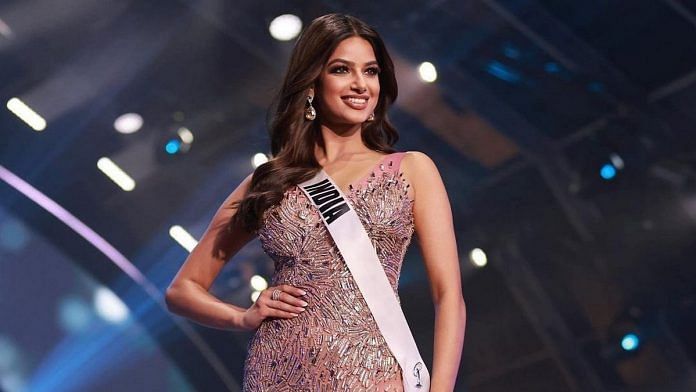Harnaaz Sandhu created history when the 21-year-old was crowned Miss Universe, ending the 21-year title drought for India. She joined the league of former winners Sushmita Sen and Lara Dutta—the only two winners in Indian history who brought the crown home. But what do beauty pageants even mean in 2021?
We have raced ahead to learn and be more inclusive—campaigns on body positivity, diversity, and inclusivity have gained momentum to the extent that the premier lingerie brand Victoria’s Secret suffered losses for refusing to change and grow. At a time when anyone can be a ‘beauty queen’ on social media, Miss Universe has become a crown of the past.
What the pageant has been about
The international beauty pageant started in 1952 as a marketing stunt by Pacific Knitting Mills, a California clothing company, after 1951 Miss America Yolande Betbeze refused to pose in their swimsuit. The company decided to endorse its own pageant and held its first contest in Longbeach, California in 1952.
While diversity in terms of race and ethnicity was always present — with the pageant essentially being a global platform for humanitarian enterprises—the premise is ultimately how well your body fits into the beauty standards of its time. We are looking at slim women who are tall and articulate in a certain manner.
I am often reminded of Sandra Bullock-starrer Miss Congeniality. In one of the scenes, the undercover cop—played by Bullock—passionately answers a question and talks about bringing change in the US prison system. Unsurprisingly, she has to end it with the standard answer—world peace—for the judges to mark her well.
Also read: India’s Harnaaz Sandhu crowned Miss Universe 2021, brings home title after 21 years
The beauty queen factory
Today, the situation has not changed much for Miss Universe. The fact that it has an age limit of 27, requires women to be unmarried, and still has a swimsuit category means its standards are skewed, and that’s putting it politely. There is also a country-specific height requirement. How does height decide who is beautiful when it is purely a genetic feature?
News reports say that Harnaaz Sandhu was bullied at school for being too thin. That is the reality we should really be focussing on. While thin-shaming is real, fat-shaming permeates deeper recesses of our society, and unless we change to be more inclusive, pageants are definite relics of the past.
While the official site may not mention it, anyone who has watched the Miss Universe show will instantly figure out that there is a body type that is considered eligible for qualification. And those criteria begin as individual countries host the national version of the pageant.
Social media has changed it all
The end of the title drought for India is exciting news, but is it really? In a country still stuck with beauty described as ‘fair, slim, and tall’, what does a pageant like Miss Universe change? Not much. But it is also a fact that pageants provide the opportunity for a lot of women to step into the highly competitive world of modelling and Bollywood. Think Sushmita Sen, Lara Dutta, Aishwarya Rai, Priyanka Chopra, Manushi Chhillar.
However, in the age of social media, everyone is a queen—quite literally. And you can get a Netflix role or a Bollywood job just by being an influencer. We now have the space to be exactly who we are, embrace our flaws, and still race ahead. We can be any size and create our own kingdom, and even earn. Your personal profile can be your very own platform for a ‘Miss Whatever’ you want and choose to be. From brand endorsements to event appearances, influencers or social media celebrities are being paid to do what earlier beauty queens could only hope for, be it at the local, national or international level.
This is a marked departure from the pre-social media era, where magazines were the be-all and end-all of how successful you are in the world of glamour. But now, magazines are fading away, and so is their monopoly on specific beauty standards. India’s influencer market is booming and is expected to reach Rs 2,200 crore by 2025. The financial pull is also instrumental in spurring everyone to create and be their own version of beauty queens.
From the era of broadcasting a Miss Universe or Miss World pageant to now streaming it on your phone, the perception of beauty has changed, and rightly so. The background does not need to be aesthetic, and one does not need a bikini and heels to be the reigning beauty of the world.
Of course, I distinctly remember the excitement when Aishwarya Rai and Sushmita Sen won the Miss World and Miss Universe pageants in 1994, and when Priyanka Chopra, Lara Dutta, and Dia Mirza landed a hattrick with their wins in 2000.
It was a tremendous honour to watch these women rule the world stage when India lacked representation in the world of modelling. But let’s look at Manushi Chhillar’s win in 2017 at the Miss World pageant. Are we still as excited? I do not think so, because there is definitely introspection about how we ask young women to love themselves and appreciate their values.
Views are personal.
(Edited by Humra Laeeq)



